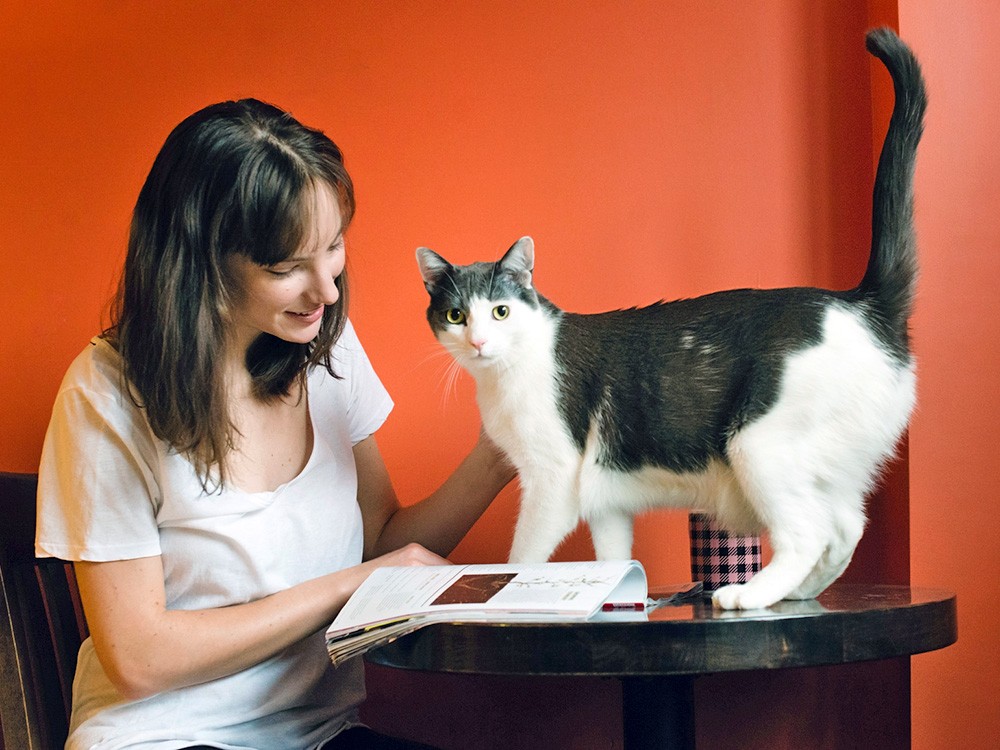They’re trying to tell you something when their tail quivers as you stroke them. Let’s decode this feline behavior.
Cat owners often witness a curious behavior: while being petted, their cat’s tail stands tall and begins to vibrate or quiver. This can be perplexing, but understanding this action is key to grasping feline communication. A vibrating cat tail, especially when you pet your cat, is usually a sign of excitement, anticipation, or even arousal. It’s a common way for cats to express their feelings, particularly during greetings or when marking their territory, although it happens in other contexts as well.
This fascinating behavior is an automatic response controlled by the nervous system and typically indicates heightened interest or a readiness to engage. But to truly understand “tail-speak,” especially when petting is involved, we need to delve deeper into the nuances of feline tail language.
Decoding Cat Tail Language: More Than Just a Wag
Feline communication is a rich tapestry woven from various signals, including ear position, eye dilation, whisker direction, overall body posture, and, significantly, their fur and tail. A cat’s tail position is a vital element of their body language, often serving as one of the most apparent indicators of their emotional state. The visibility of the tail from a distance is particularly useful in inter-cat communication, especially when assessing the approachability and mood of another feline – is it a friendly encounter, or should one maintain distance?
“Tail-speak” is not just for human-cat interactions; it’s a crucial communication tool among cats themselves, helping them navigate social dynamics and avoid potential conflicts. Understanding these tail signals can significantly improve the human-cat bond and enhance our ability to respond appropriately to our feline companions.
Context is Key to Tail Interpretation
Interpreting your cat’s tail vibrations accurately, especially when you are petting them, requires considering the surrounding context. Is your cat relaxed in their familiar home environment while you are petting them, or are they in a new or potentially stressful situation? Are they being petted in a way they enjoy, or might the petting be overstimulating? Contextual clues are crucial because certain tail movements can have different meanings depending on the situation. For instance, a tail vibration during petting in a calm environment might signal pure joy, while the same vibration in a vet’s office could indicate anxiety.
Understanding Tail Positions and Movements
Generally, a higher tail carriage suggests confidence and friendliness in cats. A tail held straight up or with a slight curve at the tip is often a sign of social engagement and happiness, particularly when directed towards a person they trust who is petting them.
Conversely, a tail tucked low or wrapped around the body may indicate insecurity or anxiety. A tail that is rhythmically twitching or thumping can signal irritation or overstimulation, prompting caution in your interactions. And a tail with puffed-up fur, along with raised fur along the back (piloerection), typically signifies fear or aggression, suggesting it’s best to give the cat space.
Why the Vibration? Reasons Behind Tail Quivers During Petting
The vibrating cat tail, especially when it occurs as you pet your cat, usually points to heightened emotions. While there are several possible reasons for this shaky tail phenomenon, excitement and anticipation are commonly at the heart of it. Here are specific reasons why your cat’s tail might vibrate when you are petting them:
Excitement and Happiness: The “I Love This” Tail
If you have a loving bond with your cat, you’re likely familiar with tail vibrations during petting sessions. This is often a high compliment! When your cat vibrates their tail as you stroke them, especially if they are also purring and kneading, it’s a strong indicator of happiness and contentment. They are likely enjoying the interaction and expressing their positive feelings towards you and the physical affection you are giving them. Consider it a feline thumbs-up!
Territory Marking & Arousal
While seemingly unrelated to petting, tail vibration is also associated with urine spraying, a territorial marking behavior. Cats may vibrate their tails in a similar manner even without releasing urine – known as “phantom spraying.” In the context of petting, this type of vibration might indicate a form of arousal or heightened state. The act of petting, particularly around the base of the tail, can sometimes stimulate these marking instincts. It’s not necessarily territorial aggression in this petting context, but more about a deep-seated instinctual response being triggered by the physical interaction.
Heightened Senses & Anticipation
Petting sessions can be highly stimulating for cats. The gentle touch, combined with your attention and presence, can heighten their senses and lead to anticipation of more positive interaction, such as play or treats that might follow petting. This anticipation and sensory excitement can manifest as a tail vibration. They might be vibrating their tail in happy anticipation of what comes next in your interaction.
Anxiety or Overstimulation
While less common in positive petting scenarios, it’s important to acknowledge that tail vibrations can sometimes indicate anxiety or overstimulation, even during petting. If your cat becomes suddenly tense, their ears flatten, or their pupils dilate while their tail vibrates during petting, they might be signaling discomfort or overstimulation. It’s crucial to observe other body language cues to differentiate between happy excitement and anxious arousal. If you suspect anxiety, reduce the intensity or duration of petting and observe if the tail vibration subsides along with other signs of stress.
Other Reasons for Cat Tail Vibrations (Beyond Petting)
While our focus is on tail vibrations during petting, understanding other reasons for this behavior in different contexts provides a more complete picture of feline communication:
Impatience
Just as humans might tap their feet when impatient, cats can express impatience with tail movements. This might not be the same intense vibration seen with excitement, but a more subtle twitch or swish. If your cat is waiting for food or a toy and you’re taking too long, you might see this impatient tail twitch.
Anger
An angry cat’s tail movements are distinctly different. Instead of vibration, an angry cat will typically swish their tail rapidly back and forth or thump it forcefully against the ground. These are strong warning signals to avoid interaction and give the cat space to calm down. While less likely to be confused with happy petting vibrations, it’s good to know the difference.
In many cases, especially when you are petting your cat, tail vibrations are overwhelmingly positive, indicating happiness and excitement in your interaction. However, by observing the entire context, considering other body language, and understanding the range of tail signals, you can become fluent in “cat-speak” and deepen your bond with your feline friend.
What to Do When Your Cat’s Tail Vibrates During Petting
When you notice your cat’s tail vibrating as you pet them, here’s a quick guide to interpreting and responding appropriately:
- Observe other body language: Is your cat purring, kneading, and relaxed, or are they tense with flattened ears? Positive signs indicate happy excitement.
- Consider the context: Are you petting them in a calm, familiar environment, or is there something potentially stressful happening?
- Positive Reinforcement: If the tail vibration is accompanied by positive signs, continue the petting and enjoy the bonding moment! You’re making your cat happy.
- Potential Overstimulation/Anxiety: If you notice signs of tension or discomfort alongside the vibration, gently stop petting and observe if they relax. Adjust your petting style in the future to avoid overstimulation.
Understanding why your cat’s tail vibrates, especially when you pet them, is a wonderful way to connect with your feline companion on a deeper level and respond to their emotional cues effectively.
FAQs (People also ask):
Is it normal for a cat’s tail to vibrate when I pet her?
Yes, it is perfectly normal and often a positive sign when a cat’s tail vibrates while you are petting her. It’s part of their wide range of tail movements used for communication. Many cats use this “shaky-tail” to express happiness, excitement, or a heightened state of arousal during petting.
What does a vibrating cat tail mean specifically when petting?
When your cat’s tail vibrates as you pet her, it most commonly indicates happiness and excitement related to your interaction. It can also signify anticipation or a form of arousal. While less common in positive petting contexts, be mindful of signs of anxiety or overstimulation as potential reasons, especially if accompanied by negative body language cues.
Could the tail vibration mean my cat is annoyed when I pet her?
While tail swishing or thumping usually indicates annoyance or anger, a tail vibration is less likely to signify annoyance during petting unless accompanied by other negative signals like flattened ears, hissing, or attempts to move away. Always consider the entire body language and context to accurately interpret your cat’s feelings.
References:
Marci Koski, CFTBP, FFCP
Marci Koski’s lifelong passion for cats led her to transition from a career in endangered species biology to founding Feline Behavior Solutions, a cat behavior consulting service. Since 2014, she has dedicated herself to helping cat owners understand and resolve feline behavior issues by educating them on how to provide environments and resources that allow cats to thrive alongside their human families.
Marci holds a PhD in Fishery and Wildlife Biology and has earned specialized certifications in Feline Training and Behavior from the Animal Behavior Institute, achieving the CFTB Professional credential. She is also a Fear Free Certified Professional (animal trainer) and a professional member of several esteemed organizations, including the Pet Professional Guild (PPG), the International Association of Animal Behavior Consultants (IAABC), the Cat Writers’ Association (CWA), and the American Association of Feline Practitioners (AAFP).
All articles

